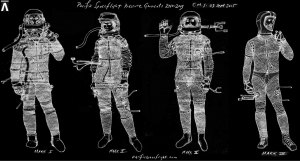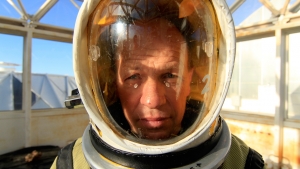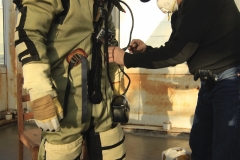
A decade ago archaeologist at Portland State Dr. Cameron Smith redirected his knowledge and passion for human history toward the future of our species as we become interplanetary. His academic publications and books project a social—even biological evolution as we move to the planets and stars.
 Cameron launched Pacific Spaceflight (PSF) to explore design, construction, and validation of low-cost, fully functional pressure suits that enable every-day citizens to reach the edge of space and beyond. These personal spacecraft are a critical aspect of off-world exploration, no matter if you are at 65,000 feet above sea level, on-orbit, or on the Moon or Mars. More than a novelty, PSF suits have been tested under water, in vacuum chambers, in the open cockpit of aircraft and in high altitude balloon projects. Cameron’s dynamic team of volunteers (including Kai Staats and Trent Tresch of a Space Analog for the Moon and Mars (SAM)) have both contributed to and been influenced by his critical work.
Cameron launched Pacific Spaceflight (PSF) to explore design, construction, and validation of low-cost, fully functional pressure suits that enable every-day citizens to reach the edge of space and beyond. These personal spacecraft are a critical aspect of off-world exploration, no matter if you are at 65,000 feet above sea level, on-orbit, or on the Moon or Mars. More than a novelty, PSF suits have been tested under water, in vacuum chambers, in the open cockpit of aircraft and in high altitude balloon projects. Cameron’s dynamic team of volunteers (including Kai Staats and Trent Tresch of a Space Analog for the Moon and Mars (SAM)) have both contributed to and been influenced by his critical work.
 On Tuesday, March 2, at 7:00 am John Adams, Deputy Director of the University of Arizona Biosphere 2 engaged in the other-world journey of donning a pressure suit to conduct a number of tests for mobility and tool use, both of which can be challenging when encumbered by a sealed suit under greater than ambient pressure.
On Tuesday, March 2, at 7:00 am John Adams, Deputy Director of the University of Arizona Biosphere 2 engaged in the other-world journey of donning a pressure suit to conduct a number of tests for mobility and tool use, both of which can be challenging when encumbered by a sealed suit under greater than ambient pressure.
This endeavor was conducted inside and around the historic Biosphere 2 Test Module, now five weeks into a major refurbish and construction endeavor as the cornerstone of SAM. This event was a fully immersed operational test of the equipment, suit, and procedures which SAM researchers will enjoy when a part of this analog experience. SAM has purchased two suits from Smith Aerospace Garments that will be available for team members to use in the half acre SAM Mars yard just outside of the living quarters and Test Module.
The specs for this particular pressure suit are as follows:
- Suit model: Pacific Spaceflight, experimental Mk SE I (2018-2019)
- Suit construction: sealed bladder with high-durability outer garment; attached boots and gloves with removable helmet
- Air composition: standard mix of ~78/21% nitrogen/oxygen levels
- Pressure inside the suit: ~1.0 psi over ambient
- Suit pressure max spec: 3.5 psi over ambient
- Compressed air source: dual feed, oil-free air compressor with 4 gallon reserve
Cameron engaged John in the suit-up procedure for approximately 30 minutes (full photo gallery below). At this time the air compressor inside the Test Module simultaneously fed John’s suit directly and a manifold that enables controlled gas exchange to the outside world. Of his own accord he opened the bulkhead door and proceeded outside. There, his feed line was switched to the manifold exterior. The momentary break from his air source was possible due to the suit acting as a short-duration buffer. SAM teams will carry a small, portable compressed air source that will provide continuous flow as feed lines are swapped from airlock to the hab exterior.
With the assistance of Cameron and Trent, John conducted a basic walk, followed by tool use, ladder climb, CO2 level check, and ascent of the exterior of the Test Module lung. This prototype suit was designed for mobility, but has been surpassed by the current models which will be delivered to SAM by late spring 2021.
In conclusion John shared, “The suit is amazing! I feel really good … all things considered, you still have quite a bit of dexterity, quite a bit of ability to lift your legs, to move around complex objects. To have an opportunity to experience a pressurized suit in a simulation setting is incredible. I feel really fortunate to have this opportunity.”
We extend our thanks to the University of Arizona’s Aaron Bugaj for exceptional photography, Katie Morgan for work with social media, and Megan Russell and Britney Swiniuch for your support and enthusiasm for this first-ever pressure suit test at SAM.


